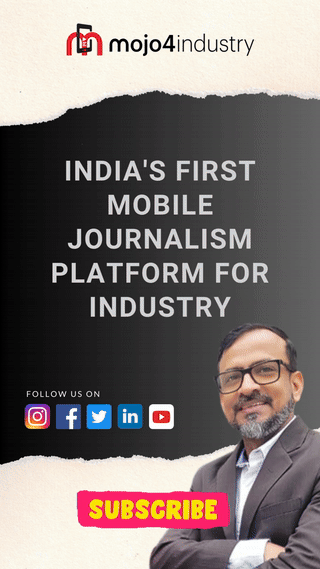ZEISS sees huge growth in India | IMTEX 2023 | metrology
ZEISS sees huge growth in India
ZEISS is one of the global majors in the field of industrial metrology and delivers CNC coordinate measuring machines and complete solutions for multidimensional metrology in the metrology lab and production. The company is increasing its focus on India as it sees huge growth potential for market leadership.
Participating in the recently held IMTEX 2023, Roger Bayer, Head of Sales APAC, ZEISS Industrial Quality Solutions and Aveen Padmaprabha, Business Head – IQS, Carl Zeiss India (Bangalore) shares their views with mojo4industry on the market and industry.
What’s your opinion on the metrology market and how the market is behaving?
The metrology market is developing quite fast here because quality control is the key in the future and what are the drivers here are that the whole world is in an industrial revolution here. There’s a big transformation started and when you transform you have to develop new applications you have to, develop new technologies you have to expand them, and what are the key qualities also in your process to stabilize the process. And there are a lot of transformation processes started where these quality aspects or this quality insurance is not yet developed at the level it should be, means that drives our challenges now.
How significant is Indian business as far as Zeiss group is concerned?
India is one of the critical markets for Zeiss and as you know we are one of the fastest growing economies, now we are in the fifth position right now and all poised you know to become the third largest by 2030. In terms of the economy, there is already a big growth that is projected and when there is economic growth in a country, there will attract a lot of investments and these investments are because of the geopolitical challenges that we are seeing, also because of the environment we create for industries in India like you all know that the government is pushing a lot of Investments under the product linked incentives scheme. So, there is a big push from the government also to invest in India. So many companies are coming to India investing and they all have to be they have to be good enough if they have to compete with global customers I mean or rather with international competitors and also serve the requirements of the international customers. so they have to uplift their quality standards whatever they have and that is where we see a huge market that is developing in front of us.
Where do you see the global business of Zeiss being driven by which are the industrial core sectors?
It is in several areas we have this we see these peak transformations. One is for example, the so-called real new electric vehicle, which means we need to go because also of environmental reasons, we need to go away from the combustion engine to the electrical engine is one thing. Then we have the number of electronic components is increasing very much, which means electronics are scaling up to a dimension that we haven’t seen before.
The next thing is power and energy somehow you have to produce electrical energy do we have enough solutions? Like fossil energy plants will not be the solution you see all the environmental problems and these will develop as a pressure we get from the environment, the demand, and especially for the highly developed countries we need to be the driver in this transformation. We need to make sure that these technologies will be made available in the future for the whole world.
Also, medical we have the medical demand is huge here we have overarching populations like in Germany and Europe is very strong we have it the same in China yeah in Japan very strong. That means here the investments are huge and the need is also huge when you look all together these are big transformations that are started but the time with which these changes will happen is much faster than the older industrial transformations.
Mr. Roger was saying that electric vehicles which are the e-mobility, energy, electronics, as well as medical, are the core sectors that are going to drive your business, is the same thing going to happen even in the Indian market?
Yes, the same segments where we are seeing the investments flowing into Indian companies. Now coming forward to put up their new plants, and their new facilities, these are the same segments that we are also targeting in India, and for all these segments today we are confident to say that we have solutions. Coming to India, India is again a huge market for automotive as you know, when it comes to two-wheelers or when it comes to cars, the penetration of these into the population is still not happening. India is still a huge market for vehicle consumption so the automotive demand is will be there will continue to be there and apart from Automotive then you have all these sunshine sectors which are going to explode in the next two to three years where we see a huge opportunity.
What are your expectations from the Indian market?
My expectations from the Indian market are that it gets also let me say a very important pillar in the supply chain for the global world and I see this happening there are a lot of foreign investments going in here, a lot of partnerships are going in here, we need to raise the quality standards. But in combination with all of this, you should not forget the environment we need to work also on environmental Solutions which means we need also that India itself is has a very quiet fast transformation into better Technologies like EVs, wind energy here, and also medical yeah you need it also for your for the support of the population.
What kind of year-on-year growth do you foresee? What kind of expectations do you have?
I see the future with even more dynamic growth. And when you compare it for example to the development in the last 10-15 years in China, you have a growth of around 7 percent, I think it will go up to a few years for double-digit values. But hopefully not too long because I shall tell you over a long time even kills you here and this is very Dynamic.
Apart from whatever Roger mentioned the other big change that will happen in India is our manufacturing footprint. Today we have certain machines that are Made in India. Hence, as we go along this transformation that Roger mentioned we’ll also add many more localized products that will be made in India because that is the only way we can serve this market and also the global market from here so we will have more and more of machines that will come to India which we’ll be making here and the investments are already in place.
Do you see value in making it in India?
Yes, suddenly it adds a lot of value to our customers. In terms of the supply chain, in terms of the cost being competitive, in terms of serviceability of these machines, quick turnaround times, availability of spares you know all these are big advantages when it comes to making this product in India and that is the road map that we have drawn for ourselves in the next three to five years to add more and more products to our existing manufacturing.
What’s your take on the kind of target that Roger was saying? Is it too ambitious for you?
No, I think looking at the environment all around us, looking at the positive buzz the industry is going through yes, it is challenging but we have said Roger we will do it.
Yeah, we’ll say and I am confident that we can somehow manage it here we will find the right solutions and we are already manufacturing and this will continue here.







